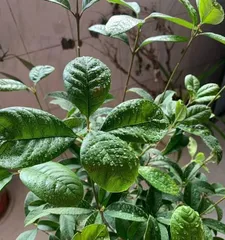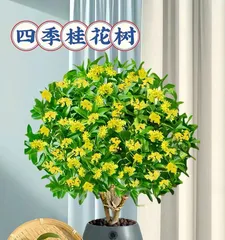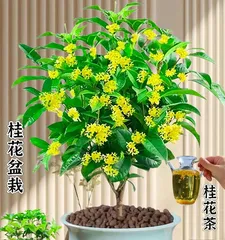Osmanthus is one of the famous traditional flowers in China, widely cultivated and appreciated for its rich fragrance and high ornamental value. In today's fast-paced life, more and more people are choosing to grow osmanthus bonsai at home. However, for some beginners, the care of osmanthus bonsai is not always satisfactory, especially during the winter. In this article, we will provide a detailed introduction on how to properly care for osmanthus bonsai in winter.

I. Watering
The weather is dry in winter, but we must master the amount and timing of watering. Overwatering can lead to root rot, affecting the normal growth of osmanthus. Generally, water once every 7-10 days, ensuring the soil is not dry.
II. Ventilation
Ventilation is also a crucial step in winter, but pay attention to keeping warm. You can open the windows for ventilation during the day, but remember to close them at night to prevent the low temperature from harming the osmanthus. At the same time, ventilation also promotes the growth of plants and keeps the air fresh.

III. Fertilizing
Osmanthus grows slowly in winter but still requires adequate nutrition. You can use organic fertilizer or compound fertilizer, applying it once every 15-20 days. However, be mindful of the amount of fertilizer; do not over-fertilize, as it can have adverse effects on the osmanthus.
IV. Suitable Temperature
Osmanthus bonsai needs a suitable temperature to grow normally in winter. Generally, the most suitable temperature is 15℃-20°C. Temperatures that are too high or too low will affect the normal growth of the plant.
V. Sun Protection
The sunlight is weaker in winter, but sun protection is still necessary. Prolonged exposure to the sun can cause the leaves to turn yellow and lose their ornamental value. You can use sunshade nets or move the pot to provide shade.

VI. Lighting
Light is weaker in winter, so it's necessary to supplement with artificial lighting. You can choose LED lights or fluorescent lamps to ensure the plant receives adequate light.
VII. Cold Protection
The temperature is low in winter, so osmanthus needs appropriate cold protection measures. You can move the pot indoors to prevent the plant from being frost-damaged. You can also insulate the pot by covering it with materials like straw or soil.
VIII. Pest Control
Pests are also common in winter, such as aphids and whiteflies. You can use appropriate insecticides or biological agents to control pests. However, be careful not to overuse chemical products to avoid harming the osmanthus.
IX. Pruning
Pruning the osmanthus branches appropriately in winter can promote growth. You can trim away unwanted branches to keep the plant tidy.
X. Insulation Cover
If the temperature is too low, you can cover the top of the pot with an insulating material, such as plastic film, to increase the internal temperature.
XI. Humidity Control
The climate is dry in winter, but plants need appropriate humidity to grow. You can spray water around the pot or use a humidifier to increase humidity.
XII. Repotting
If you find the soil in the pot is too loose or has lost its fertility, it is time to repot. When repotting, be careful with the roots and keep them intact.
XIII. Preventing Leaf Wilting
In winter, osmanthus leaves are prone to wilting. At this time, you need to water promptly and can also spray some nutrient solution on the leaves to promote growth.
XIV. Dormancy Period
Osmanthus also has a dormancy period in winter. During this time, reduce operations like fertilizing and watering. However, you cannot stop care completely, as this can easily lead to the death of the plant.
XV.
Caring for osmanthus bonsai in winter involves many aspects, including watering, ventilation, fertilizing, suitable temperature, sun protection, lighting, cold protection, pest control, pruning, insulation cover, humidity control, repotting, preventing leaf wilting, and paying attention to the dormancy period. Only by mastering these care techniques can your osmanthus bonsai grow more robustly during the winter.